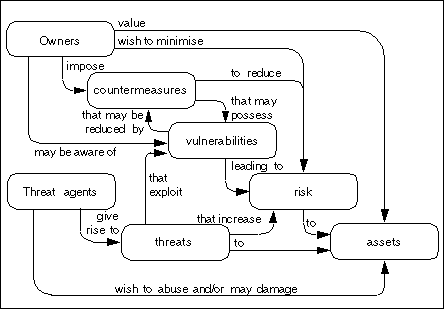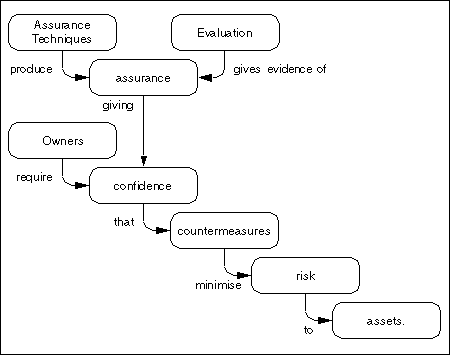
This clause presents the general concepts used throughout the CC, including the context in which the concepts are to be used and the CC approach for applying the concepts. Part 2 and Part 3 expand on the use of these concepts and assume that the approach described is used. This clause assumes some knowledge of IT security and does not propose to act as a tutorial in this area.
The CC discusses security using a set of security concepts and terminology. An understanding of these concepts and the terminology is a prerequisite to the effective use of the CC. However, the concepts themselves are quite general and are not intended to restrict the class of IT security problems to which the CC is applicable.
Security is concerned with the protection of assets from threats, where threats are categorised as the potential for abuse of protected assets. All categories of threats should be considered; but in the domain of security greater attention is given to those threats that are related to malicious or other human activities. Figure 4.1 illustrates high level concepts and relationships. illustrates high level concepts and relationships.

Safeguarding assets of interest is the responsibility of owners who place value on those assets. Actual or presumed threat agents may also place value on the assets and seek to abuse assets in a manner contrary to the interests of the owner. Owners will perceive such threats as potential for impairment of the assets such that the value of the assets to the owners would be reduced. Security specific impairment commonly includes, but is not limited to, damaging disclosure of the asset to unauthorised recipients (loss of confidentiality), damage to the asset through unauthorised modification (loss of integrity), or unauthorised deprivation of access to the asset (loss of availability).
The owners of the assets will analyse the possible threats to determine which ones apply to their environment. The results are known as risks. This analysis can aid in the selection of countermeasures to counter the risks and reduce it to an acceptable level.
Countermeasures are imposed to reduce vulnerabilities and to meet security policies of the owners of the assets (either directly or indirectly by providing direction to other parties). Residual vulnerabilities may remain after the imposition of countermeasures. Such vulnerabilities may be exploited by threat agents representing a residual level of risk to the assets. Owners will seek to minimise that risk given other constraints.

Figure 4.2 - Evaluation concepts and relationships
Owners will need to be confident that the countermeasures are adequate to counter the threats to assets before they will allow exposure of their assets to the specified threats. Owners may not themselves possess the capability to judge all aspects of the countermeasures, and may therefore seek evaluation of the countermeasures. The outcome of evaluation is a statement about the extent to which assurance is gained that the countermeasures can be trusted to reduce the risks to the protected assets. The statement assigns an assurance rating of the countermeasures, assurance being that property of the countermeasures that gives grounds for confidence in their proper operation. This statement can be used by the owner of the assets in deciding whether to accept the risk of exposing the assets to the threats. Figure 4.2 illustrates these relationships. illustrates these relationships.
Owners of assets will normally be held responsible for those assets and should be able to defend the decision to accept the risks of exposing the assets to the threats. This requires that the statements resulting from evaluation are defensible. Thus, evaluation should lead to objective and repeatable results that can be cited as evidence. evaluation should lead to objective and repeatable results that can be cited as evidence.
Many assets are in the form of information that is stored, processed and transmitted by IT products or systems to meet requirements laid down by owners of the information. Information owners may require that dissemination and modification of any such information representations (data) be strictly controlled. They may demand that the IT product or system implement IT specific security controls as part of the overall set of security countermeasures put in place to counteract the threats to the data.
IT systems are procured and constructed to meet specific requirements and may, for economic reasons, make maximum use of existing commodity IT products such as operating systems, general purpose application components, and hardware platforms. IT security countermeasures implemented by a system may use functions of the underlying IT products and depend upon the correct operation of IT product security functions. The IT products may, therefore, be subject to evaluation as part of the IT system security evaluation.
Where an IT product is incorporated or being considered for incorporation in multiple IT systems, there are cost advantages in evaluating the security aspects of such a product independently and building a catalogue of evaluated products. The results of such an evaluation should be expressed in a manner that supports incorporation of the product in multiple IT systems without unnecessary repetition of work required to examine the product's security.
An IT system accreditor has the authority of the owner of the information to determine whether the combination of IT and non-IT security countermeasures furnishes adequate protection for the data, and thus to decide whether to permit the operation of the system. The accreditor may call for evaluation of the IT countermeasures in order to determine whether the IT countermeasures provide adequate protection and whether the specified countermeasures are properly implemented by the IT system. This evaluation may take various forms and degrees of rigour, depending upon the rules imposed upon, or by, the accreditor.